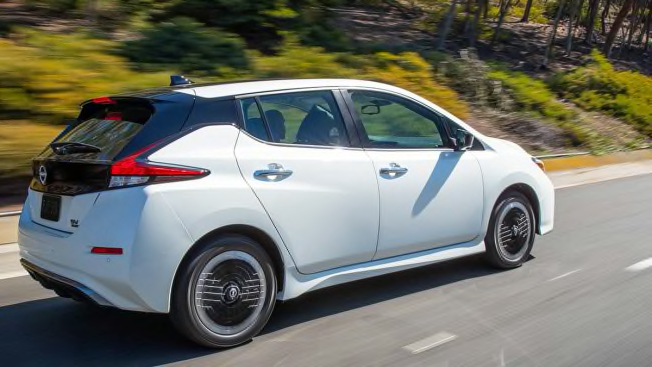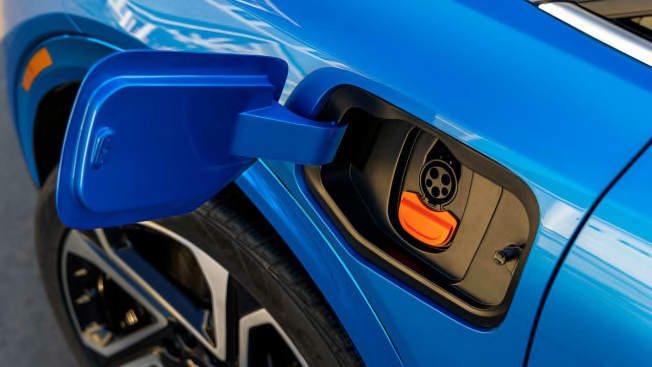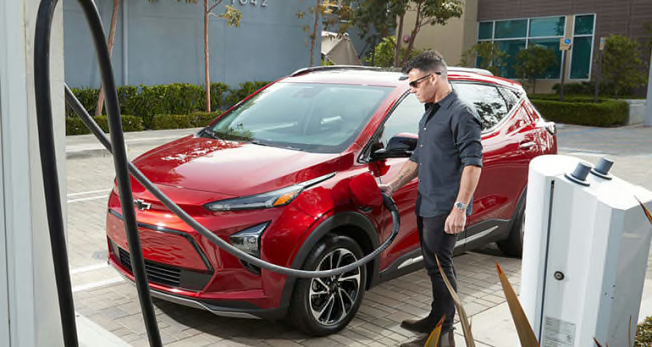Electric Cars and Plug-In Hybrids That Qualify for Federal Tax Credits
Here’s how to find out which new and used EVs may qualify for a tax credit of up to $7,500 for 2023 and 2024
If you’re thinking about buying an electric car or a plug-in hybrid, you should be aware that the list of vehicles that are eligible for a federal EV tax credit of up to $7,500 is different as of Jan. 1, 2024. But the new year also brings an easier way for car buyers to get the credit if they qualify.
The credit already depends on where EVs are made, where their battery components and minerals come from, how much they cost, and how much buyers earn. Some of those rules have become stricter in 2024, which may disqualify additional vehicles. The restrictions may not apply if an EV is leased instead of purchased. Also starting in 2024, eligible buyers are able to get the tax credit as an instant discount at the dealership as soon as they purchase the car rather than waiting for tax season.
The tax credit is part of the Inflation Reduction Act of 2022. Designed to address climate change, healthcare, and taxes, the legislation also modifies how tax credits for certain new EV purchases are calculated. The provisions of the act went into effect in phases. Vehicles must be manufactured in North America and have an MSRP below $80,000 for an SUV and $55,000 for a sedan, wagon, or hatchback.
- EV tax credits: Which Electric Cars Get a Tax Credit for 2024? Which EVs Lose Their Tax Credit for 2024? Which New-Car Purchases Might Have Qualified in 2023? How Do You Claim the EV Tax Credit? What Is the Income Limit for the EV Tax Credit? The Rules Why Does the EV Tax Credit Keep Changing? Do Leased EVs Qualify for a Full Tax Credit? Do Used EVs Qualify for a Tax Credit? Which Cars May Qualify Only for the New EV Tax Credit If Leased?
Which Electric Cars Get a Tax Credit for 2024?
The Treasury Department’s official list of eligible vehicles shows that the following vehicles qualify for a full $7,500 tax credit if placed in service between Jan. 1 and Dec. 31 of 2024:
- Cadillac Lyriq (2024 model year, MSRP $80,000 or below)
- Chevrolet Bolt and Bolt EUV (2022 and 2023 model years, MSRP $55,000 or below)
- Chevrolet Blazer EV (2024 model year, MSRP $80,000 or below)
- Chrysler Pacifica Hybrid PHEV (2022 through 2024 model years, MSRP $80,000 or below)
- Ford F-150 Lightning (2022 through 2024 model years, MSRP $80,000 or below)
- Honda Prologue (2024 model year, MSRP $80,000 or below)
- Tesla Model 3 Performance (2023 and 2024 model years, MSRP $55,000 or below)
- Tesla Model X Long Range (2023 and 2024 model years, MSRP $80,000 or below)
- Tesla Model Y All-Wheel Drive (2023 and 2024 model years, MSRP $80,000 or below); Performance (2023 and 2024 model years, MSRP $80,000 or below); and Rear-Wheel Drive (2024 model year only, MSRP $80,000 or below)
- Volkswagen ID.4 standard, S, Pro S Plus, Pro S, Pro, AWD Pro, AWD Pro S, and AWD Pro S Plus (most 2023 and 2024 model year with SK On battery components, MSRP $80,000 or below)
The following vehicles qualify for a partial $3,750 tax credit if placed in service between Jan. 1 and Dec. 31 of 2024:
- Audi Q5 PHEV (2023 and 2024 model years, MSRP $80,000 or below)
- Ford Escape Plug-In Hybrid (2022 through 2024 model years, MSRP $80,000 or below)
- Jeep Grand Cherokee 4xe (2022 through 2024 model years, MSRP $80,000 or below)
- Jeep Wrangler 4xe (2022 through 2024 model years, MSRP $80,000 or below)
- Lincoln Corsair Grand Touring (2022 through 2024 model years, MSRP $80,000 or below)
- Nissan Leaf (2024 model year, sold on or after March 6, 2024, MSRP $55,000 or below)
- Rivian R1S and R1T (2022 through 2024 model years, MSRP $80,000 or below)
Although it is not on the official list, Acura says it expects the ZDX SUV to qualify for a partial tax credit as well, as long as the vehicle’s MSRP is below $80,000.
Which EVs Lose Their Tax Credit for 2024?
- The Rear Wheel Drive and Long Range versions of the Tesla Model 3 will no longer qualify for a $7,500 tax credit.
- The Ford Mustang Mach-E and E-Transit van and the Lincoln Aviator Grand Touring plug-in hybrid (PHEV) will no longer qualify.

Photo: Nissan Photo: Nissan
Which New-Car Purchases Might Have Qualified in 2023?
The IRS says the manufacturers of the following EVs and PHEVs indicated that the vehicles are eligible for a full tax credit of $7,500 if they were placed in service before the end of 2023, provided other requirements are met, such as vehicle MSRP and buyer income, which are explained in detail later in this article:
- Cadillac Lyriq (2023 and 2024 model years, MSRP $80,000 or below)
- Chevrolet Bolt (2022 and 2023 model years, MSRP $55,000 or below)
- Chevrolet Bolt EUV (2022 and 2023 model years, MSRP $55,000 or below)
- Chevrolet Blazer EV (2024 model year, MSRP $80,000 or below)
- Chevrolet Equinox (2024 model year, MSRP $80,000 or below)
- Chevrolet Silverado EV (2024 model year, MSRP $80,000 or below)
- Chrysler Pacifica PHEV (2022, 2023, and 2024 model years, MSRP $80,000 or below)
- Ford F-150 Lightning (2022 and 2023 model years, MSRP $80,000 or below)
- Lincoln Aviator Grand Touring PHEV (MSRP $80,000 or below)
- Tesla Model 3 Long Range AWD, Performance, and Standard Range RWD (2022 and 2023 model years, MSRP $55,000 or below)
- Tesla Model X Long Range (2023 model year, MSRP $80,000 or below)
- Tesla Model Y All-Wheel Drive, Long Range, and Performance (2022 and 2023 model years for All-Wheel Drive and Long Range, 2022 model year only for Performance, MSRP $80,000 or below)
- Volkswagen ID.4 (2023 model year, MSRP $80,000 or below)
Many of these vehicles may also qualify for state and local incentives. You can find out more in CR’s EV incentive finder. Not all of these vehicles are currently on sale.
If a manufacturer uses different suppliers or assembly locations, some vehicles may qualify while others may not, even if they’re the same make and model. That was initially true for the Tesla Model 3 Standard Range, which at one time only qualified for a partial credit. Other vehicles may qualify in the future after automakers make changes to their battery and component suppliers, or if the U.S. signs free-trade agreements with more countries.
The Treasury Department says the manufacturers of the following EVs and PHEVs indicated that they’re eligible for a partial tax credit of $3,750 if put into service on or after April 18, 2023, and before Dec. 31, 2023, provided other requirements are met, such as vehicle MSRP and buyer income:
- BMW X5 xDrive50e PHEV (2024 model year, MSRP $80,000 or below)
- Ford Escape PHEV (2022 and 2023 model years, MSRP $80,000 or below; may qualify for a partial tax credit of $6,843 due to battery size if put into service before April 18, 2023)
- Ford E-Transit (2022 and 2023 model years, MSRP $80,000 or below)
- Ford Mustang Mach-E (2022 and 2023 model years, MSRP $80,000 or below)
- Jeep Wrangler 4xe PHEV (2022, 2023, and 2024 model years, MSRP $80,000 or below)
- Jeep Grand Cherokee 4xe PHEV (2022, 2023, and 2024 model years, MSRP $80,000 or below)
- Lincoln Corsair Grand Touring PHEV (2022 and 2023 model years, MSRP $80,000 or below; may qualify for a partial tax credit of $6,843 due to battery size if put into service before April 18, 2023)
- Nissan Leaf (2024 model year only, if purchased and put into service before Dec. 31, 2023)
- Rivian R1S (2023 model years, MSRP $80,000 or below)
- Rivian R1T (2023 model years, MSRP $80,000 or below)
If these vehicles were put into service before April 18, 2023, owners may still qualify for a tax credit for 2023:
- Audi Q5 TFSI e Quattro PHEV
- BMW 330e sedan (2021-2023 model, may have qualified for partial credit up to $5,836 due to battery size if made in North America)
- BMW X5 xDrive45e SUV (2021-2023 model)
- Genesis GV70 Electrified SUV
- Volvo S60 PHEV (may have qualified for partial credit of $5,419 due to battery size), Extended Range, and T8 Recharge

Photo: Chevrolet Photo: Chevrolet
How Do You Claim the EV Tax Credit?
According to the IRS, for the 2023 tax year, you must file Form 8936, “Qualified Plug-In Electric Drive Motor Vehicle Credit (Including Qualified Two-Wheeled Plug-In Electric Vehicles)” with your tax return. You will also need to provide your vehicle identification number (VIN), which can be found on the registration or the dashboard at the base of the windshield.
Starting in 2024, the process will get easier. Buyers will be able to transfer their credit to an eligible car dealership at the time of purchase, which will work sort of like an instant discount on the price of the vehicle. According to the Treasury Department, over 7,400 dealers have signed up for this program so far.
To ensure that an individual vehicle qualifies for the tax credit in 2024, the Treasury Department says buyers should ask for a copy of paperwork called a "Time-of-Sale Report" that has successfully been submitted to the IRS Energy Credits Online portal before they purchase and take delivery of a new vehicle.
What Is the Income Limit for the EV Tax Credit?
It’s not just the car—it’s also the buyer. To qualify for a new car tax credit, your household income must have an adjusted gross income of up to $300,000. If you’re filing as head of household, you must earn below $225,000, and individual filers will qualify only with income below $150,000. This provision may not apply if a vehicle is leased.
The Rules
To qualify for a tax credit of up to $7,500, a new EV or eligible plug-in hybrid vehicle (PHEV) must meet certain rules:
• A vehicle’s MSRP must not exceed certain limits, so pricey EVs, such as the GMC Hummer EV, Lucid Air, and Tesla Model S, won’t qualify. For SUVs, pickup trucks, and vans, the threshold is $80,000. For sedans, hatchbacks, wagons, and other vehicles, the credit cuts off at $55,000. These limits are based on a vehicle’s MSRP, not on its sale price, so a heavily discounted luxury car would not qualify. In addition, this requirement may not apply to some leased vehicles.
• Regardless of how a vehicle is advertised, whether it counts as an SUV, wagon, or hatchback is determined by the Environmental Protection Agency and listed on the window sticker. For example, the Ford Mustang Mach-E is listed as a small SUV, but the Chevrolet Bolt EUV is classified as a small station wagon.
• A vehicle must be assembled in North America, including Canada and Mexico, to qualify for any tax credit. This eliminates credits for vehicles assembled elsewhere, including the BMW i4, Hyundai Ioniq 5, Kia EV6, and Toyota bZ4X. (This requirement also may not apply to some leased vehicles.) It doesn’t matter if a vehicle comes from an Asian or European brand, only where it’s assembled.
• To qualify for a full tax credit, at least 50 percent of a vehicle’s battery components must be produced or assembled in North America. In addition, at least 40 percent of critical minerals used in the battery must be extracted or processed in the U.S. or in a country that’s a U.S. free-trade agreement partner, or they must have been made from materials recycled in North America. The new rules will become stricter over time, with requirements increasing by 10 percent each year through 2027. By then, 90 percent of battery components and 80 percent of critical minerals will have to meet the guidelines.
• Car buyers must meet certain income guidelines. Households with an adjusted gross income up to $300,000 will still qualify for the new-car credit, while heads of household must earn below $225,000 and individual filers will qualify only with income below $150,000. This provision may not apply if a vehicle is leased.
• PHEVs with a battery of at least 7 kWh may qualify for a tax credit as long as they meet all of the other requirements. For PHEVs, the tax credit is calculated either as 15 percent of the vehicle’s MSRP, the dollar difference between the cost of the PHEV and a similarly equipped gas-powered version of the same vehicle, or $7,500—whichever is lowest.
• Starting in 2024, vehicles with battery components sourced from countries that have been designated “foreign entities of concern"—including companies owned by, controlled by, or subject to the jurisdiction or direction of the governments of China, Iran, North Korea, and Russia—will no longer be eligible for a tax credit. Automakers will be responsible for tracing their supply chains, and the IRS will determine which vehicles meet the criteria.
• There’s no longer a 200,000 vehicle sales cap on tax credits that made EVs and plug-in hybrids from Tesla, GM, and Toyota ineligible under earlier rules. Previously, once an automaker sold more than 200,000 qualifying vehicles, the credit began to phase out.
CR’s EV Incentive Finder can also tell you whether the model you’re interested in may be eligible for a federal tax credit, as well as state and local incentives that might save you thousands more.

Photo: Chevrolet Photo: Chevrolet
Why Does the EV Tax Credit Keep Changing?
The Treasury Department says that the new rules are aimed at moving EV manufacturing and sourcing away from China and to the U.S. and its free-trade partners, which are Australia, Bahrain, Canada, Chile, Colombia, Costa Rica, the Dominican Republic, El Salvador, Guatemala, Honduras, Israel, Jordan, South Korea, Mexico, Morocco, Nicaragua, Oman, Panama, Peru, and Singapore. They also now include Japan, after it entered into a special minerals-focused trade agreement with the U.S. signed just before the new rules were released, and may expand to include countries in the European Union as well, Reuters reports. A 2022 analysis of the EV supply chain from the International Energy Agency shows that a vast majority of minerals, components, and battery cells are currently from China.
Although directives about battery and mineral sourcing are meant to provide an incentive for manufacturing in the U.S., automakers and EV advocates have told Consumer Reports they’re concerned that the complexity of these rules may make it difficult for consumers to find a vehicle that qualifies for the credits or understand how much they’ll be eligible to claim.
Chris Harto, CR’s senior policy analyst for transportation and energy, says it’s no surprise that fewer cars qualify for a credit. “The requirements were going to be difficult for automakers to meet immediately,” he says, “but we expect this list to grow quite a bit in the coming months and years as automakers now have clear targets to hit to become eligible, and are working hard to qualify.”
Do Leased EVs Qualify for a Full Tax Credit?
There’s some good news if the car you want to purchase doesn’t qualify for a tax credit. A Treasury spokesperson told CR that most traditional leases would qualify for a $7,500 commercial credit that’s not subject to the myriad requirements that must be met to qualify for the consumer new-vehicle credit.
Here’s how it works: In the case of a lease, the dealer would receive the commercial credit, not the person leasing the vehicle, and it would be up to the dealer to pass those savings on to the consumer, potentially by lowering the vehicle’s purchase price. If a dealer does pass the savings along, drivers could get a tax credit on a car made outside North America, such as the popular Hyundai Ioniq 5. High-income consumers and those who lease a high-cost EV, such as a Lucid Air or Tesla Model S would also be able to enjoy the $7,500 credit as long as the dealer passes those savings along.
If a buyer chooses to do this, however, they should make sure to double-check the dealership’s math. “Make sure to ask for an itemized bill of sale that shows where the tax credit has been applied,” says Gabe Shenhar, associate director of CR’s Auto Test Center. “And make sure the dealership doesn’t mark up the price of the car accordingly.”
Some automakers, including Hyundai, Lucid, and Polestar, already factor in a full $7,500 tax credit to the lease deals listed on their websites. Learn more about leasing here.
Do Used EVs Qualify for a Tax Credit?
For the first time, buyers of used EVs will get a tax credit, either $4,000 or 30 percent of the sale price of the vehicle, whichever is lower. But that’s only if they buy a car from a dealership, and only if the vehicle wasn’t previously resold after Aug. 16, 2022. In other words, a one-owner used car sold at an authorized dealership may be eligible for a tax credit, but a two-owner car won’t be. Neither will a one-owner car sold privately.
The income threshold is lower for used EV buyers: $150,000 for joint filers, $112,500 for a head of household, and $75,000 for an individual. But the rules about where the car was made or where the battery comes from don’t apply to used vehicles.
Which Cars May Qualify Only for the New EV Tax Credit If Leased?
In addition to the vehicles listed above that lost out on a tax credit starting April 18, 2023 because of battery and critical mineral requirements, these current and coming EVs (and two fuel-cell vehicles) aren’t made in North America, so they probably won’t qualify for a tax credit if they’re purchased. But that might change in the future if their assembly location changes. In addition, dealers may pass a tax credit on to consumers if the vehicle is leased instead of purchased.
Regardless of where they’re assembled, these vehicles have an MSRP that’s too high and won’t qualify for any tax credit if they’re purchased, although dealers may pass a tax credit on to consumers if the vehicle is leased:
- Audi E-Tron GT
- BMW i4
- BMW i7
- BMW iX
- Chevrolet Silverado EV (certain options and trim levels above $80,000)
- Ford F-150 Lightning (certain options and trim levels above $80,000)
- Genesis G80 Electric
- GMC Hummer EV
- Lucid Air
- Mercedes-Benz EQE and EQE SUV
- Mercedes-Benz EQS and EQS SUV
- Porsche Taycan
- Rivian R1T and R1S (if options and trim levels push the price above $80,000)
- Tesla Cybertruck (certain options and trim levels)
- Tesla Model S





















